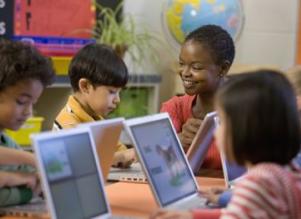1/29/2017
5 Problems Blended Learning Can Help You Solve
Effective blended learning requires rethinking the challenges of how classroom instruction is structured, how time is spent, and how limited resources are used.
There are a number of different models of blended learning, but if any of the following challenges sound familiar, blended learning could be the answer to your problems.
1.) I need to differentiate instruction for students at various skill levels
Blended learning enhances education in a way that traditional classrooms cannot. Instead of a one-size-fits-all approach, adaptive instruction in a blended model enables students to master new concepts at their own pace and provides teachers the data and instructional resources to give struggling students the individualized attention that they need. Most implementations of this model feature a rotational approach. According to the Christensen Institute for Disruptive Innovation, in the rotational approach, one-third of the class works independently through online learning (with some element of student control over time, place, path, or pace). The next third work in small groups, perhaps on a project that demonstrates their learning. The remaining third receive direct instruction from the teacher, filling in gaps identified when the teacher reviewed the data collected while students worked in the online program.
2.) I don’t have the right tools to connect student data to instruction
A successful blended learning program includes the collection of data and recommends next steps for the teacher. Using easy-to-access and simple-to-interpret data, teachers can identify the granular areas in which students excel or struggle. This helps teachers with instructional prioritization, grouping students with similar needs, and strengthening interventions. For example, while three students may all struggle with spatial awareness, the specific skills they find challenging may be different. The data collected in a blended learning model can help educators identify the exact skills with which students struggle, thereby avoiding reteaching skills that students have already mastered. Additionally, many teachers use these data reports in parent conferences and end-of-year student promotion decisions. This provides a much more well-rounded picture of student growth and helps bridge the gap between school instruction and home involvement.
3.) My students need more time to learn
The differentiated instruction blended learning provides improves the quality of learning time in the classroom by allowing students to work at their own pace and making it possible for the teacher to group students for small-group instruction by their areas of need, maximizing instructional time. There is no more waiting for the other half of the class to catch up before moving on to the next skill. Additionally, with the use of mobile technology (laptops, e-readers, tablets) and computer labs, learning can be expanded outside of the classroom in before- and after-school programs, and home computers allow students to keep learning even when school is out.
4.) I need more classroom flexibility
Blended learning does not eliminate the role of creative teaching in the classroom. Instead, it takes a large, intimidating group of students and breaks it down into more manageable chunks. This way, more creative lesson ideas can go through an iterative process. Blended learning provides additional support for teachers to work with small groups of struggling students while other students work independently on skill development or automaticity. Technology will never replace a teacher, but it can provide much-needed flexibility for a single teacher to support a class with a wide range of abilities. Ultimately, the goal of an effective blended learning program is to enhance flexibility, not only in terms of how each student learns but also with regard to how educators approach instruction.
5.) My students need to meet digital literacy requirements
Achieving digital literacy is at the center of Common Core and other rigorous state standards. The difference is that even though today's students are digital natives who were able to navigate devices before they could speak, they still need to be instructed on appropriate uses and applications of technology. According to The International Society for Technology in Education, a nonprofit organization that serves educators interested in better use of technology in education, “Technology gives us the power to do things we’ve never been able to do before. These new capacities are revolutionizing the way we communicate, work, and live. We must prepare the next generation not only to use these new tools, but also to foster the habits of mind that will enable them to keep up in their changing world.”


